-

新人教版高中英语选修2Unit 1 Science and Scientists-Reading and thinking教学设计
Step 5: After learning the text, discuss with your peers about the following questions:1.John Snow believed Idea 2 was right. How did he finally prove it?2. Do you think John Snow would have solved this problem without the map?3. Cholera is a 19th century disease. What disease do you think is similar to cholera today?SARS and Covid-19 because they are both deadly and fatally infectious, have an unknown cause and need serious public health care to solve them urgently.keys:1. John Snow finally proved his idea because he found an outbreak that was clearly related to cholera, collected information and was able to tie cases outside the area to the polluted water.2. No. The map helped John Snow organize his ideas. He was able to identify those households that had had many deaths and check their water-drinking habits. He identified those houses that had had no deaths and surveyed their drinking habits. The evidence clearly pointed to the polluted water being the cause.3. SARS and Covid-19 because they are both deadly and fatally infectious, have an unknown cause and need serious public health care to solve them urgently.Step 6: Consolidate what you have learned by filling in the blanks:John Snow was a well-known _1___ in London in the _2__ century. He wanted to find the _3_____ of cholera in order to help people ___4_____ it. In 1854 when a cholera __5__ London, he began to gather information. He ___6__ on a map ___7___ all the dead people had lived and he found that many people who had ___8____ (drink) the dirty water from the __9____ died. So he decided that the polluted water ___10____ cholera. He suggested that the ___11__ of all water supplies should be _12______ and new methods of dealing with ____13___ water be found. Finally, “King Cholera” was __14_____.Keys: 1. doctor 2. 19th 3.cause 4.infected with 5.hit 6.marked 7.where 8.drunk 9.pump 10.carried 11.source 12.examined 13.polluted 14.defeatedHomework: Retell the text after class and preview its language points

新人教版高中英语选修2Unit 1 Science and Scientists-Using langauge教学设计
This happens because the dish soap molecules have a strong negative charge, and the milk molecules have a strong positive charge. Like magnets, these molecules are attracted to each other, and so they appear to move around on the plate, taking the food coloring with them, making it look like the colors are quickly moving to escape from the soap.Listening text:? Judy: Oh, I'm so sorry that you were ill and couldn't come with us on our field trip. How are you feeling now? Better?? Bill: Much better, thanks. But how was it?? Judy: Wonderful! I especially liked an area of the museum called Light Games.it was really cool. They had a hall of mirrors where I could see myself reflected thousands of times!? Bill: A hall of mirrors can be a lot of fun. What else did they have?? Judy: Well, they had an experiment where we looked at a blue screen for a while, and then suddenly we could see tiny bright lights moving around on it. You'll never guess what those bright lights were!? Bill: Come on, tell me!? Judy: They were our own blood cells. For some reason, our eyes play tricks on us when we look at a blue screen, and we can see our own blood cells moving around like little lights! But there was another thing I liked better. I stood in front of a white light, and it cast different shadows of me in every color of the rainbow!? Bill: Oh, I wish I had been there. Tell me more!? Judy: Well, they had another area for sound. They had a giant piano keyboard that you could use your feet to play. But then, instead of playing the sounds of a piano, it played the voices of classical singers! Then they had a giant dish, and when you spoke into it, it reflected the sound back and made it louder. You could use it to speak in a whisper to someone 17 meters away.? Bill: It all sounds so cool. I wish I could have gone with you? Judy: I know, but we can go together this weekend. I'd love to go there again!? Bill: That sounds like a great idea!

新人教版高中英语选修2Unit 2 Bridging Cultures-Discovering useful structures教学设计
The grammar of this unit is designed to review noun clauses. Sentences that use nouns in a sentence are called noun clauses. Nominal clauses can act as subject, object, predicate, appositive and other components in compound sentences. According to the above-mentioned different grammatical functions, nominal clauses are divided into subject clause, object clause, predicate clause and appositive clause. In this unit, we will review the three kinds of nominal clauses. Appositive clauses are not required to be mastered in the optional compulsory stage, so they are not involved.1. Guide the students to judge the compound sentences and determine the composition of the clauses in the sentence.2. Instruct students to try to learn grammar by generalizing grammar rules, controlling written practice, and semi-open oral output.3. Inspire the students to systematize the function and usage of noun clause1.Instruct students to try to learn grammar by generalizing grammar rules, controlling written practice, and semi-open oral output.2.Inspire the students to systematize the function and usage of noun clauseStep1: The teacher ask studetns to find out more nominal clauses from the reading passage and udnerline the nominal clauses.

新人教版高中英语选修2Unit 3 Food and Culture-Discovering useful structures教学设计
The newspaper reported more than 100 people had been killed in the thunderstorm.报纸报道说有一百多人在暴风雨中丧生。(2)before、when、by the time、until、after、once等引导的时间状语从句的谓语是一般过去时,以及by、before后面接过去的时间时,主句动作发生在从句的动作或过去的时间之前且表示被动时,要用过去完成时的被动语态。By the time my brother was 10, he had been sent to Italy.我弟弟10岁前就已经被送到意大利了。Tons of rice had been produced by the end of last month. 到上月底已生产了好几吨大米。(3) It was the first/second/last ... time that ...句中that引导的定语从句中,主语与谓语构成被动关系时,要用过去完成时的被动语态。It was the first time that I had seen the night fact to face in one and a half years. 这是我一年半以来第一次亲眼目睹夜晚的景色。(4)在虚拟语气中,条件句表示与过去事实相反,且主语与谓语构成被动关系时,要用过去完成时的被动语态。If I had been instructed by him earlier, I would have finished the task.如果我早一点得到他的指示,我早就完成这项任务了。If I had hurried, I wouldn't have missed the train.如果我快点的话,我就不会误了火车。If you had been at the party, you would have met him. 如果你去了晚会,你就会见到他的。

新人教版高中英语选修2Unit 3 Food and Culture-Reading and thinking教学设计
The discourse explores the link between food and culture from a foreign’s perspective and it records some authentic Chinese food and illustrates the cultural meaning, gerography features and historic tradition that the food reflects. It is aimed to lead students to understand and think about the connection between food and culture. While teaching, the teacher should instruct students to find out the writing order and the writer’s experieces and feelings towards Chinese food and culture.1.Guide the students to read the text, sort out the information and dig out the topic.2.Understand the cultural connotation, regional characteristics and historical tradition of Chinese cuisine3.Understand and explore the relationship between food and people's personality4.Guide the students to use the cohesive words in the text5.Lead students to accurately grasp the real meaning of the information and improve the overall understanding ability by understanding the implied meaning behind the text.1. Enable the Ss to understand the structure and the writing style of the passage well.2. Lead the Ss to understand and think further about the connection between food and geography and local character traits.Step1: Prediction before reading. Before you read, look at the title, and the picture. What do you think this article is about?keys:It is about various culture and cuisine about a place or some countries.

新人教版高中英语选修2Unit 5 First Aid-Discovering useful structures教学设计
You have no excuse for not going.你没有理由不去。He was punished for not having finished his homework.他因未完成作业而受到惩罚。2.动词ing形式复合结构由物主代词或人称代词宾格、名词所有格或普通格加动词ing,即“sb./sb.'s+doing”构成。动词ing形式的复合结构实际上是给动词ing形式加了一个逻辑主语。动词ing形式的复合结构有四种形式:①形容词性物主代词+动词ing②名词所有格+动词ing③代词宾格+动词ing④名词+动词ingHer coming to help encouraged all of us.她来帮忙鼓舞了我们所有人。The baby was made awake by the door suddenly shutting.这个婴儿被突然的关门声吵醒了。Can you imagine him/Jack cooking at home?你能想象他/杰克在家做饭的样子吗?无生命名词无论是作主语还是作宾语都不能用第②种形式。Tom's winning first prize last year impressed me a lot.汤姆去年得了一等奖使我印象深刻。Do you mind my/me/Jack's/Jack leaving now?你介意我/杰克现在离开吗?Excuse me for my not coming on time.很抱歉我没能按时来。His father's being ill made him worried.他父亲病了,他很担心。We are looking forward to the singer's/the singer to give us a concert.我们盼望着这位歌手来给我们举办一场演唱会。
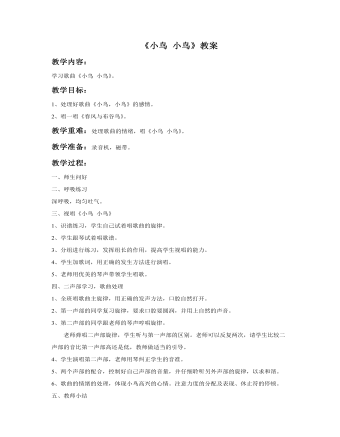
《小鸟 小鸟》教案
一、师生问好二、呼吸练习深呼吸,均匀吐气。三、视唱《小鸟小鸟》1、识谱练习,学生自己试着唱歌曲的旋律。2、学生跟琴试着唱歌谱。3、分组进行练习,发挥组长的作用,提高学生视唱的能力。4、学生加歌词,用正确的发生方法进行演唱。5、老师用优美的琴声带领学生唱歌。四、二声部学习,歌曲处理1、全班唱歌曲主旋律,用正确的发声方法,口腔自然打开。2、第一声部的同学复习旋律,要求口腔要圆润,并用上自然的声音。3、第二声部的同学跟老师的琴声哼唱旋律。老师弹唱二声部旋律,学生听与第一声部的区别。老师可以反复两次,请学生比较二声部的音比第一声部高还是低,教师做适当的引导。
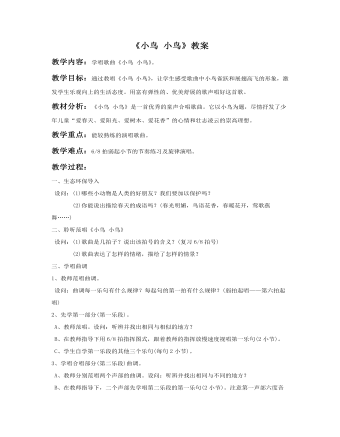
《小鸟 小鸟》教案
一、生态环保导入 设问:(1)哪些小动物是人类的好朋友?我们要加以保护吗? (2)你能说出描绘春天的成语吗?(春光明媚,鸟语花香,春暖花开,莺歌燕舞……)二、聆听范唱《小鸟 小鸟》 设问:(1)歌曲是几拍子?说出该拍号的含义?(复习6/8拍号) (2)歌曲表达了怎样的情绪,描绘了怎样的情景?三、学唱曲调1、教师范唱曲调。 设问:曲调每一乐句有什么规律?每起句的第一拍有什么规律?(弱拍起唱——第六拍起唱)2、先学第一部分(第一乐段)。 A、教师范唱。设问:听辨并找出相同与相似的地方?
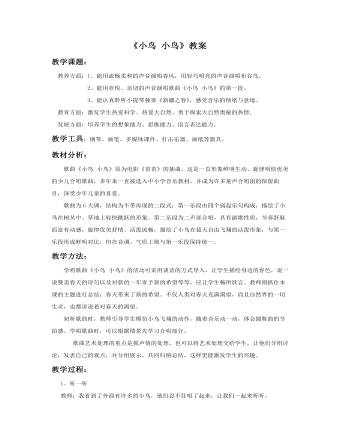
《小鸟 小鸟》教案
学唱歌曲《小鸟 小鸟》的活动可采用谈话的方式导入,让学生描绘身边的春色,说一说赞美春天的诗句以及对新的一年寄予新的希望等等,应让学生畅所欲言。教师则抓住本课的主题进行总结:春天带来了新的希望。不仅人类对春天充满渴望,而且自然界的一切生灵,也都诉说着对春天的渴望。 初听歌曲时,教师引导学生模仿小鸟飞翔的动作,随着音乐动一动,体会圆舞曲的节拍感。学唱歌曲时,可以根据情景先学习合唱部分。 歌曲艺术处理的重点是抓声情的处理。也可以将艺术处理交给学生,让他们分组讨论,发表自己的观点,并分组展示,共同归纳总结,这样更能激发学生的兴趣。

《小鸟 小鸟》教案
一、情境导入 出示几幅风景画,展示春天的景色,感受春天的美景。老师说:“小鸟非常的可爱,给我们的生活带来了无穷的乐趣,下面我们就来听一首歌曲《小鸟 小鸟》,听后请你们说说自己的感受。”二、寓教于乐 学生初听歌曲,感受歌曲情绪。学生表达自己的感受:欢跃、亲切地、活泼地…… 教师:这样一首欢快的歌曲你们想不想知道它唱得是什么内容呀?(学生回答)下面就请大家认真听一听歌曲中都唱了什么?学生听歌曲内容,听后复述:春天里有阳光,树林里有花香,小鸟在自由地飞翔,在田野,在草地,在湖边,在山岗,小鸟迎着春天歌唱…… 学生再次聆听歌曲,熟悉歌曲内容。
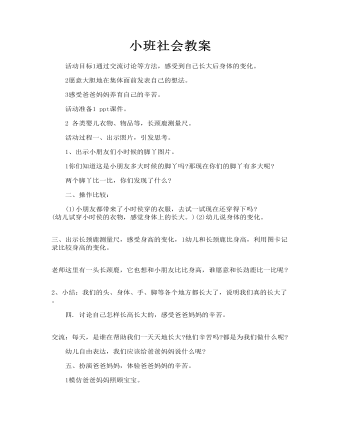
小班社会教案
(1)小朋友都带来了小时侯穿的衣服,去试一试现在还穿得下吗? (幼儿试穿小时侯的衣物,感觉身体上的长大。)(2)幼儿说身体的变化。 三、出示长颈鹿测量尺,感受身高的变化,1幼儿和长颈鹿比身高,利用图卡记录比较身高的变化。 老师这里有一头长颈鹿,它也想和小朋友比比身高,谁愿意和长劲鹿比一比呢? 2、小结:我们的头、身体、手、脚等各个地方都长大了,说明我们真的长大了。 四. 讨论自己怎样长高长大的,感受爸爸妈妈的辛苦。
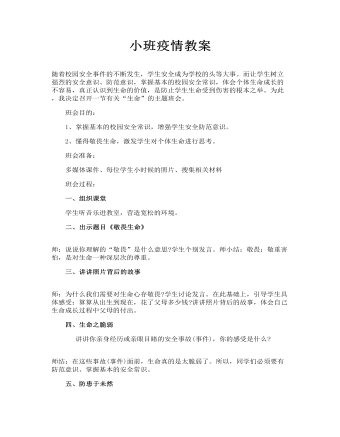
小班疫情教案
一、组织课堂 学生听音乐进教室,营造宽松的环境。 二、出示题目《敬畏生命》 师:说说你理解的“敬畏”是什么意思?学生个别发言。师小结:敬畏:敬重害怕,是对生命一种深层次的尊重。 三、讲讲照片背后的故事 师:为什么我们需要对生命心存敬畏?学生讨论发言。在此基础上,引导学生具体感受:算算从出生到现在,花了父母多少钱?讲讲照片背后的故事,体会自己生命成长过程中父母的付出。
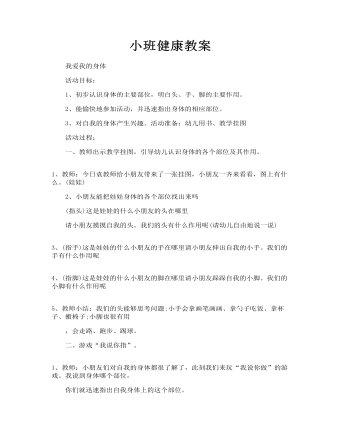
小班健康教案
活动过程: 一、教师出示教学挂图,引导幼儿认识身体的各个部位及其作用。 1、教师:今日袁教师给小朋友带来了一张挂图,小朋友一齐来看看,图上有什么。(娃娃) 2、小朋友能把娃娃身体的各个部位找出来吗 (指头)这是娃娃的什么小朋友的头在哪里 请小朋友摸摸自我的头。我们的头有什么作用呢(请幼儿自由地说一说) 3、(指手)这是娃娃的什么小朋友的手在哪里请小朋友伸出自我的小手。我们的手有什么作用呢 4、(指脚)这是娃娃的什么小朋友的脚在哪里请小朋友跺跺自我的小脚。我们的小脚有什么作用呢
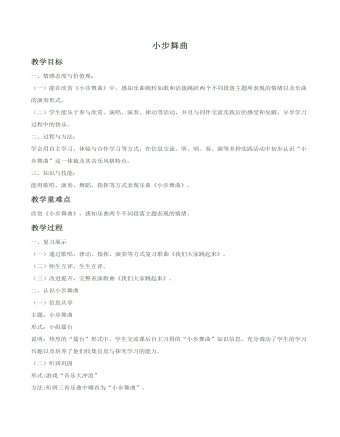
《小步舞曲》教案
教学目标 一、情感态度与价值观:(一)能在欣赏《小步舞曲》中,感知乐曲婉转如歌和活泼跳跃两个不同段落主题所表现的情绪以及乐曲的演奏形式。(二)学生能乐于参与欣赏、演唱、演奏、律动等活动,并且与同伴交流实践后的感受和见解,分享学习过程中的快乐。二、过程与方法:学会用自主学习、体验与合作学习等方式,在信息交流、听、唱、奏、演等多种实践活动中初步认识“小步舞曲”这一体裁及其音乐风格特点。三、知识与技能:能用歌唱、演奏、舞蹈、指挥等方式表现乐曲《小步舞曲》。
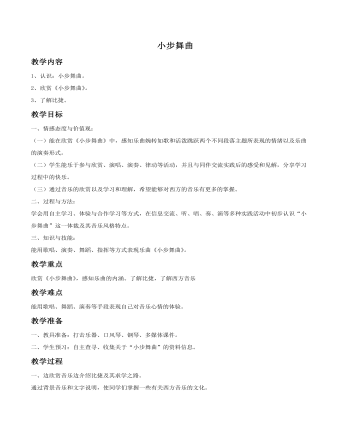
《小步舞曲》教案
教学目标一、情感态度与价值观:(一)能在欣赏《小步舞曲》中,感知乐曲婉转如歌和活泼跳跃两个不同段落主题所表现的情绪以及乐曲的演奏形式。(二)学生能乐于参与欣赏、演唱、演奏、律动等活动,并且与同伴交流实践后的感受和见解,分享学习过程中的快乐。(三)通过音乐的欣赏以及学习和理解,希望能够对西方的音乐有更多的掌握。二、过程与方法:学会用自主学习、体验与合作学习等方式,在信息交流、听、唱、奏、演等多种实践活动中初步认识“小步舞曲”这一体裁及其音乐风格特点。三、知识与技能:能用歌唱、演奏、舞蹈、指挥等方式表现乐曲《小步舞曲》。
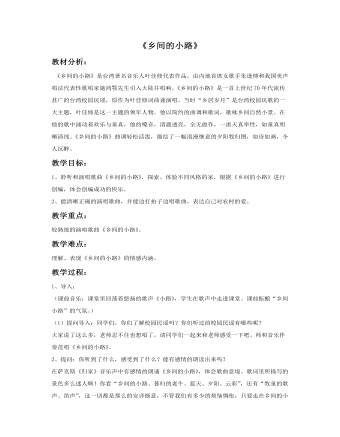
《乡间的小路》教案
教学过程:1、导入:(课前音乐:课堂里回荡着悠扬的歌声《小路》,学生在歌声中走进课堂。课前酝酿“乡间小路”的气氛。)(1)提问导入:同学们,你们了解校园民谣吗?你们听过的校园民谣有哪些呢?大家说了这么多,老师忍不住也想唱了,请同学们一起来和老师感受一下吧。师和音乐伴奏范唱《乡间的小路》。2、提问:你听到了什么,感受到了什么?能有感情的朗读出来吗?在萨克斯《归家》音乐声中有感情的朗诵《乡间的小路》,体会歌曲意境。歌词里所描写的景色多么迷人啊!你看“乡间的小路、暮归的老牛、蓝天、夕阳、云彩”,还有“牧童的歌声、笛声”,这一切都是那么的安详惬意,不管我们有多少的烦恼惆怅,只要走在乡间的小路上,它们都会随风飘散,消失得无影无踪。这么优美如诗、风光如画的歌曲,让我们再聆听一遍,请大家一边视听一边思考:歌曲可以分为几个部分?每个部分给你的情绪感受都是一样的吗?播放歌曲视频。3、新课:(1)欣赏歌曲《乡间的小路》,边听边用脚轻踩拍子,注意重拍。 a、歌曲所表现的内容是什么?情绪如何? b、歌曲的重拍在哪?是几拍子?(第二遍聆听)
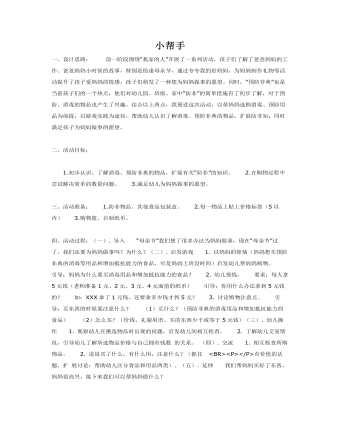
小帮手课件教案
二、活动目标:1.初步认识、了解消毒、预防非典的物品,扩展有关“防非”的知识。 2.在购物过程中尝试解决简单的数量问题。 3.满足幼儿为妈妈做事的愿望。三、活动准备: 1.防非物品、其他食品包装盒。 2.每一物品上贴上价格标签(5以内) 3.购物篮,自制纸币。四、活动过程:(一). 导入 “母亲节”我们想了很多办法为妈妈做事,现在“母亲节”过了,我们还要为妈妈做事吗?为什么?(二). 启发游戏 1. 以妈妈的烦恼(妈妈想买预防非典的消毒等用品和增加抵抗能力的食品,可是妈妈上班没时间)启发幼儿帮妈妈购物。

《端午粽》教案
1.生认真倾听老师范读,边听边思考:课文有几个自然段,写了有关粽子哪些方面的内容呢? 2.生回答老师提出的问题。3.生读第一自然段,并思考这一段的主要内容。 4.全班交流第一自然段的内容。5.观察田字格中生字“午”、“节”的笔顺和所占的位置,边描红,小组内讨论该注意的问题。6.展示并交流书写作品。7.生自读第2自然段,边读边完成老师提出的任务,组内讨论交流。8.全班交流:第2自然段主要写了端午粽哪些方面的内容呢?9.生朗读以下词语:箬竹叶糯米枣清香又黏又甜10.朗读第2自然段,在老师的引导下,准确找出相关句子:(1)外婆的粽子是用这些材料包成的:粽子是用青青的箬竹叶包的,里面裹着白白的糯米,中间有一颗红红的枣。(2)煮熟的粽子,清香扑鼻:外婆……一股清香。(3)外婆包的粽子味道美极了:剥开粽叶,……又黏又甜
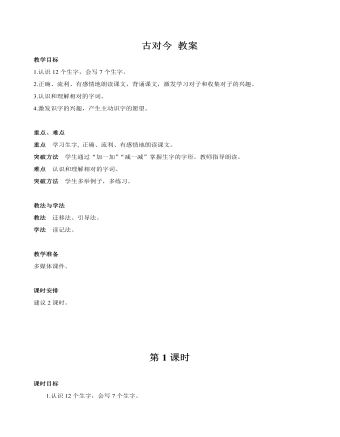
《古对今》教案
初读课文,自主识字1.学生自由读课文。师:同学们,课文中描写了大自然的美丽景色,你们想不想读?在读之前老师有个问题想问大家,在读的过程中遇到不认识的字怎么办?(借助拼音,问同学或者老师)学生自己试着读课文。2.教师指名轮流读课文。教师指名以开“小火车”的形式读课文,每人读一小节。其他学生认真听,充当小评委。3.教师用多媒体课件出示课文,其中生字用红色标记。教师组织学生齐读课文。师:读完课文后你们发现了什么?生:这些红色的字就是我们这节课的生字。4.教师指导学生认识生字。
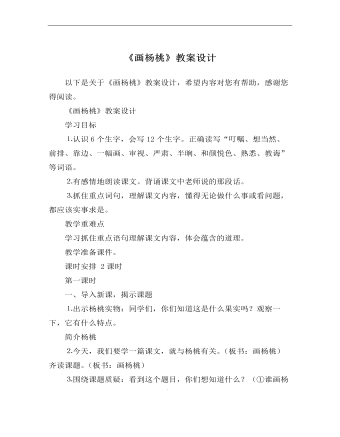
《画杨桃》教案
检查预习,理清层次 ⒈指读生字词 ⒉你理解了哪些新词意思?怎么理解的?(交流) 联系上下文理解词语 想当然:凭主观想象,认为事物应该是这样。联系课文内容,父亲经常叮嘱“我”,看见一件东西是什么样的,就画成什么样,不要凭主观想象,画走了样。 ⒊指读课文,交流:本文讲的是一件什么事?(这是一篇精读课文,主要讲的是图画课上练习画杨桃时发生的事情。) ⒋划分层次 第一段(1):略写父亲教导我画画要实事求是。 第二段(2—18):具体地叙述我把杨桃画成五角星时发生的事 第三段(19):写父亲和老师的教诲使“我”一生受用。 用连接段意法概括课文主要内容:先略写父亲教导我画画要实事求是,接着具体地叙述把杨桃画成五角星时发生的事,最后写父亲和老师的教诲使“我”一生受用。

